FIAT DUCATO BASE CAMPER 2017 Owner handbook (in English)
Manufacturer: FIAT, Model Year: 2017, Model line: DUCATO BASE CAMPER, Model: FIAT DUCATO BASE CAMPER 2017Pages: 296, PDF Size: 14.44 MB
Page 101 of 296
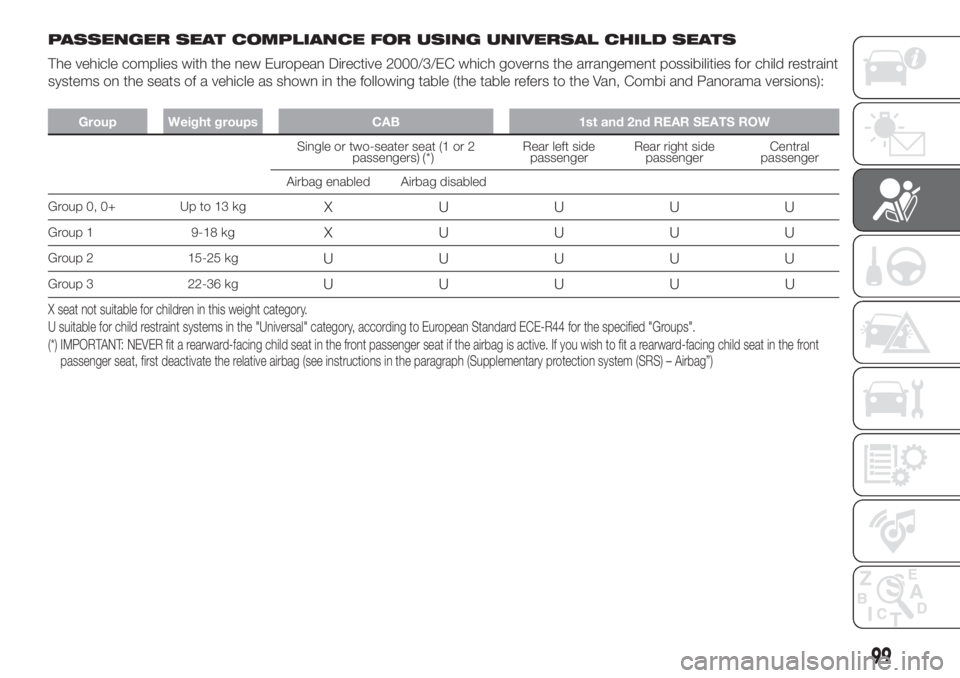
PASSENGER SEAT COMPLIANCE FOR USING UNIVERSAL CHILD SEATS
The vehicle complies with the new European Directive 2000/3/EC which governs the arrangement possibilities for child restraint
systems on the seats of a vehicle as shown in the following table (the table refers to the Van, Combi and Panorama versions):
Group Weight groups CAB 1st and 2nd REAR SEATS ROW
Single or two-seater seat (1 or 2
passengers)Rear left side
passengerRear right side
passengerCentral
passenger
Airbag enabled Airbag disabled
Group 0, 0+ Up to 13 kg
X UUUU
Group 1 9-18 kgX UUUU
Group 2 15-25 kgUUUUU
Group 3 22-36 kgUUUUU
(*)
X seat not suitable for children in this weight category.
U suitable for child restraint systems in the "Universal" category, according to European Standard ECE-R44 for the specified "Groups".
(*) IMPORTANT: NEVER fit a rearward-facing child seat in the front passenger seat if the airbag is active. If you wish to fit a rearward-facing child seat in the front
passenger seat, first deactivate the relative airbag (see instructions in the paragraph (Supplementary protection system (SRS) – Airbag”)
99
Page 102 of 296
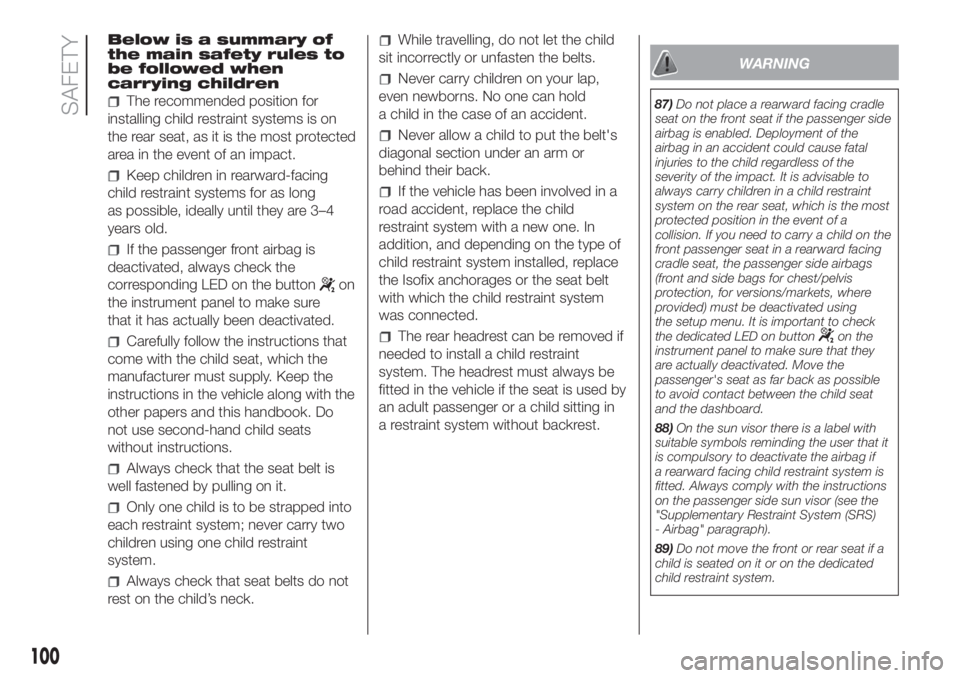
Below is a summary of
the main safety rules to
be followed when
carrying children
The recommended position for
installing child restraint systems is on
the rear seat, as it is the most protected
area in the event of an impact.
Keep children in rearward-facing
child restraint systems for as long
as possible, ideally until they are 3–4
years old.
If the passenger front airbag is
deactivated, always check the
corresponding LED on the button
on
the instrument panel to make sure
that it has actually been deactivated.
Carefully follow the instructions that
come with the child seat, which the
manufacturer must supply. Keep the
instructions in the vehicle along with the
other papers and this handbook. Do
not use second-hand child seats
without instructions.
Always check that the seat belt is
well fastened by pulling on it.
Only one child is to be strapped into
each restraint system; never carry two
children using one child restraint
system.
Always check that seat belts do not
rest on the child’s neck.
While travelling, do not let the child
sit incorrectly or unfasten the belts.
Never carry children on your lap,
even newborns. No one can hold
a child in the case of an accident.
Never allow a child to put the belt's
diagonal section under an arm or
behind their back.
If the vehicle has been involved in a
road accident, replace the child
restraint system with a new one. In
addition, and depending on the type of
child restraint system installed, replace
the Isofix anchorages or the seat belt
with which the child restraint system
was connected.
The rear headrest can be removed if
needed to install a child restraint
system. The headrest must always be
fitted in the vehicle if the seat is used by
an adult passenger or a child sitting in
a restraint system without backrest.
WARNING
87)Do not place a rearward facing cradle
seat on the front seat if the passenger side
airbag is enabled. Deployment of the
airbag in an accident could cause fatal
injuries to the child regardless of the
severity of the impact. It is advisable to
always carry children in a child restraint
system on the rear seat, which is the most
protected position in the event of a
collision. If you need to carry a child on the
front passenger seat in a rearward facing
cradle seat, the passenger side airbags
(front and side bags for chest/pelvis
protection, for versions/markets, where
provided) must be deactivated using
the setup menu. It is important to check
the dedicated LED on button
on the
instrument panel to make sure that they
are actually deactivated. Move the
passenger's seat as far back as possible
to avoid contact between the child seat
and the dashboard.
88)On the sun visor there is a label with
suitable symbols reminding the user that it
is compulsory to deactivate the airbag if
a rearward facing child restraint system is
fitted. Always comply with the instructions
on the passenger side sun visor (see the
"Supplementary Restraint System (SRS)
- Airbag" paragraph).
89)Do not move the front or rear seat if a
child is seated on it or on the dedicated
child restraint system.
100
SAFETY
Page 103 of 296

90)Incorrect fitting of the child restraint
system may result in an inefficient
protection system. In the event of an
accident the child restraint system may
become loose and the child may be
injured, even fatally. When fitting a restraint
system for newborns or children, strictly
comply with the instructions provided
by the Manufacturer.
91)When the child restraint system is not
used, secure it with the seat belt or with
the ISOFIX anchorages, or remove it from
the vehicle. Do not leave it unsecured
inside the passenger compartment. In this
way, in the case of sudden braking or an
accident, it will not cause injuries to the
occupants.
92)Always make sure that the diagonal
section of the seat belt does not pass
under the arms or behind the back of the
child. In the event of an accident the seat
belt will not be able to secure the child,
with the risk of injury, including fatal injury.
Therefore the child must always wear
the seat belt correctly.
93)The figures are only examples for fitting
purposes. Fit the child restraint system
according to the instructions, which must
be included.
94)Car seats for weight groups 0 and 1
feature an anchor in front of the vehicle
safety belts as well as its own belts to
restrain the child. Due to their weight, they
may be dangerous if incorrectly mounted
(e.g. if fastened to the vehicle seat belts
placing a cushion in between). Follow the
assembly instructions carefully.SETUP FOR
“UNIVERSAL
ISOFIX” CHILD
RESTRAINT SYSTEM
The vehicle is set up for fitting an Isofix
child restraint system.
The ISOFIX system lets you install the
ISOFIX child restraining system quickly,
simply and safely, without using the
car seat belts, but by connecting the
child restrain system directly to the car
seat with three anchors in the vehicle.
Traditional child restraint systems can
be fitted alongside ISOFIX child restraint
systems on different seats in the same
vehicle.
To install an ISOFIX child restraint
system, attach it to the two metal
anchorages A fig. 96 located where the
rear seat cushion meets the backrest,
then fix the upper strap (available
together with the restraint system) to
the dedicated anchorage B fig. 97
located at the bottom behind the
backrest.
As an example, fig. 99 shows an
example of a Universal ISOFIX child
restraint system for weight group 1.
NOTE When a Universal ISOFIX child
restraint system is used, only ECE R44
"ISOFIX Universal” (R44/03 or further
upgrades), type-approved child
restraint systems can be used fig. 98.
96F1A0156
97F1A0157
98F1B0117C
101
Page 104 of 296

WARNING: The fig. 99 is indicative and
for assembly purposes only. Fit the
child restraint system according to the
instructions, which must be included.
95) 96) 97) 98)
99F1A0155
102
SAFETY
Page 105 of 296

SUITABILITY OF PASSENGER SEATS FOR USE WITH ISOFIX CHILD SEATS
The table below shows the different installation possibilities for Universal Isofix child restraint systems on the seats fitted with
Isofix attachments, in accordance with European regulation ECE 16.
Weight groupChild restraint system
positionIsofix size classRear side Isofix
position, 1st row
(PANORAMA)Rear side Isofix position,
1st row (COMBI)
Portable cradleRear facing FXX
Rear facing GXX
Group 0 (up to 10 kg) Rear facing EIL IL
Group 0+ (up to 13 kg)Rear facing E
IL IL
Rear facing DIL IL
Rear facing CIL IL
Group1(from9upto18
kg)Rear facing D
IL IL
Rear facing CIL IL
Forward facing BIUF IUF
Forward facing B1IUF IUF
Forward facing AIUF IUF
X: ISOFIX position not suitable for ISOFIX child restraint systems in this group of weight and/or size class.
IL: suitable for Isofix child restraint systems of the "Specific for the vehicle", "Restricted", or "Semiuniversal" categories, approved for this type of vehicle.
IUF: suitable for forward facing Isofix child restraint systems in the Universal category and type-approved for the use in the weight group.
IMPORTANT The bench seat and the Crew Cab Van version 4-seater seat are not suitable for positioning a child restraint
system.
NOTE: The other weight groups are covered by specific ISOFIX child restraint systems, which can only be used if specifically
tested for this vehicle (see list of vehicles provided with the child restraint system).
103
Page 106 of 296
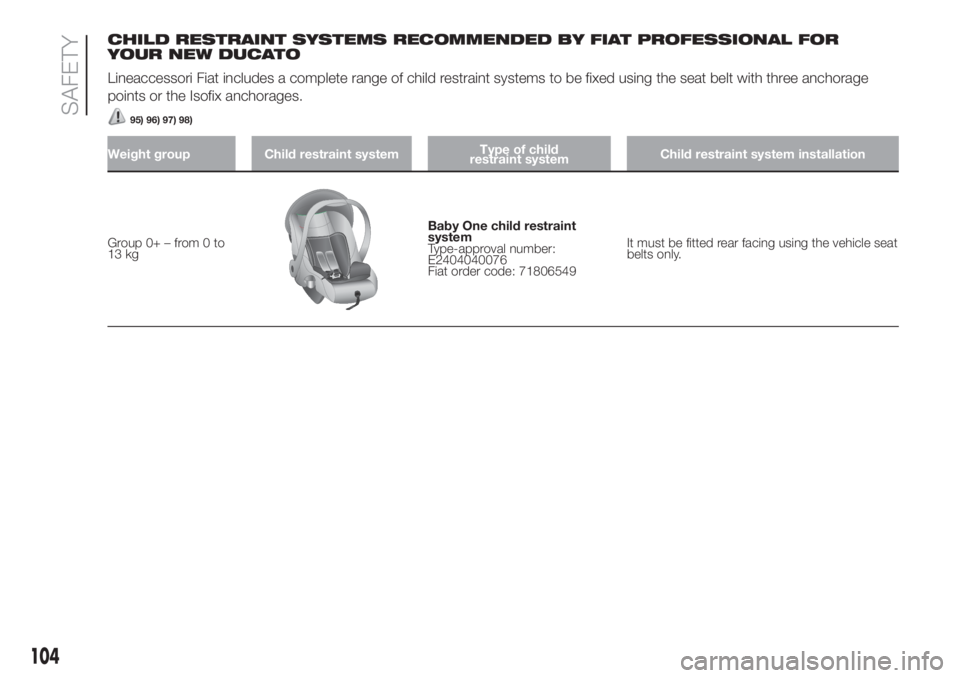
CHILD RESTRAINT SYSTEMS RECOMMENDED BY FIAT PROFESSIONAL FOR
YOUR NEW DUCATO
Lineaccessori Fiat includes a complete range of child restraint systems to be fixed using the seat belt with three anchorage
points or the Isofix anchorages.
95) 96) 97) 98)
Weight group Child restraint systemType of child
restraint systemChild restraint system installation
Group 0+ – from 0 to
13 kg
Baby One child restraint
system
Type-approval number:
E2404040076
Fiat order code: 71806549It must be fitted rear facing using the vehicle seat
belts only.
104
SAFETY
Page 107 of 296

Weight group Child restraint systemType of child
restraint systemChild restraint system installation
Group1–from9upto
18 kg
G0/1 child restraint system
Type-approval number: E4
04443718
Fiat order code: 71805991
It can be fitted forward facing/rear facing using
only the vehicle seat belts or the Isofix
anchorages.
Fiat Professional recommends fitting it using the
rear facing Isofix platform (RWF type "I" - to be
purchased separately) or the forward facing Isofix
platform (FWF type "G" - to be purchased
separately), the rigid head restraint (to be
purchased separately) and the Isofix anchorages.
It must be fitted on the rear outer seats. ++
Isofix RWF type "I" platform
for G0/1
Fiat order code: 71806309
or
Isofix FWF type "G" platform
for G0/1
Fiat order code: 71806308
++
Rigid head restraint
Order code: 71806648
105
Page 108 of 296
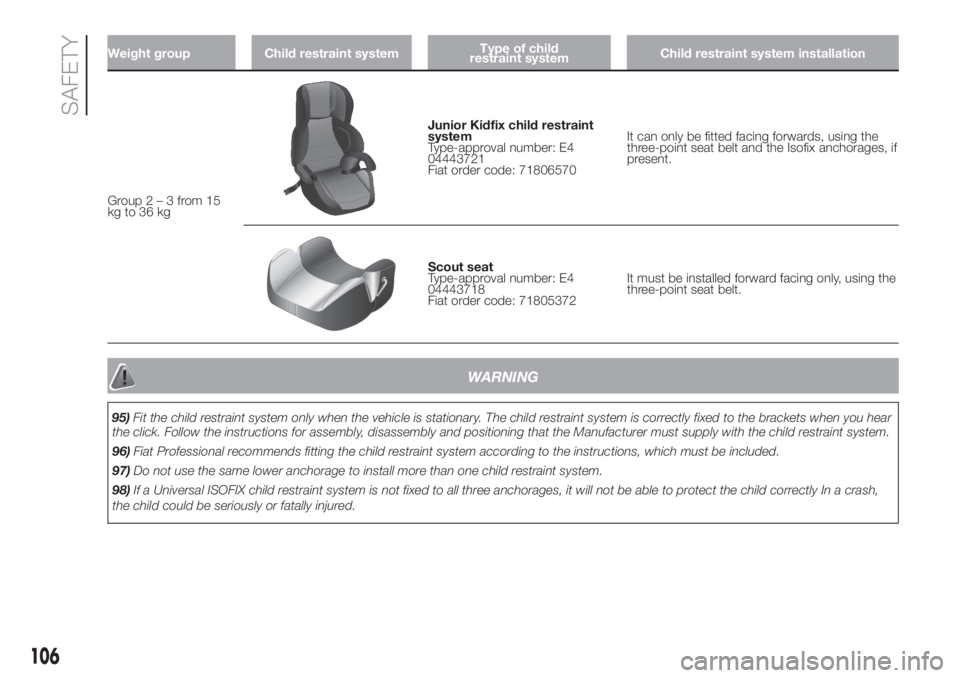
Weight group Child restraint systemType of child
restraint systemChild restraint system installation
Group2–3from15
kg to 36 kg
Junior Kidfix child restraint
system
Type-approval number: E4
04443721
Fiat order code: 71806570It can only be fitted facing forwards, using the
three-point seat belt and the Isofix anchorages, if
present.
Scout seat
Type-approval number: E4
04443718
Fiat order code: 71805372It must be installed forward facing only, using the
three-point seat belt.
WARNING
95)Fit the child restraint system only when the vehicle is stationary. The child restraint system is correctly fixed to the brackets when you hear
the click. Follow the instructions for assembly, disassembly and positioning that the Manufacturer must supply with the child restraint system.
96)Fiat Professional recommends fitting the child restraint system according to the instructions, which must be included.
97)Do not use the same lower anchorage to install more than one child restraint system.
98)If a Universal ISOFIX child restraint system is not fixed to all three anchorages, it will not be able to protect the child correctly In a crash,
the child could be seriously or fatally injured.
106
SAFETY
Page 109 of 296

SUPPLEMENTARY
RESTRAINT SYSTEM
(SRS) - AIRBAG
The vehicle may be equipped with:
driver front airbag;
passenger front airbag;
front side bags to protect the pelvis
and chest of the driver and passenger;
window bags to protect the heads
of the front seat occupants.
The airbag locations on the vehicle are
marked by the word "AIRBAG" in the
middle of the steering wheel, on the
dashboard, on the side lining or on
a label placed next to the airbag
deployment area.
FRONT AIRBAGS
The front airbags protect the front seat
occupants in the event of a medium-
high severity frontal impact, by placing
the bag between the occupant and
the steering wheel or dashboard.
Therefore, non-activation in other types
of collisions (side collisions, rear shunts,
roll-overs, etc.) is not a system
malfunction.
An electronic control unit will make the
bag inflate in the event of a frontal
impact.The bag will inflate instantaneously
placing itself between the front
occupants body and the structures
which could cause injury. It will deflate
immediately afterwards.
Front airbags are not a replacement of
but complementary to the seat belts,
which you are recommended to always
wear, as specified by law in Europe
and most non-European countries.
In the event of an impact, someone not
wearing a seat belt could move forward
and come into contact with a bag
which is still opening. The protection
offered by the bag is compromised
in these circumstances.
Front airbags may not activate in the
following situations:
frontal impacts against highly
deformable objects not involving the
front surface of the vehicle (e.g. wing
collision against guard rail, etc.);
when the vehicle is wedged under
other vehicles or protective barriers
(e.g. under a lorry or a guardrail); Failure
to deploy in the conditions described
above is due to the fact that the airbags
may not provide any additional
protection compared with seat belts, so
their activation would be inappropriate.
In these cases, non-deployment does
not indicate a system malfunction.
99)
The driver's and passenger's front
airbags have been designed and
calibrated to protect front seat
occupants wearing seat belts. At their
maximum inflation, their volume fills
most of the space between the steering
wheel and the driver and between the
dashboard and the passenger.
The airbags are not deployed in the
event of minor frontal impacts (for
which the restraining action of the seat
belts is sufficient). Seat belts must
always be worn. In the event of a frontal
collision, they ensure the correct
positioning of the occupant.
FRONT AIRBAG DRIVER'S
SIDE
It consists of an instantly inflating bag
contained in a special recess at the
centre of the steering wheel fig. 100.
100F1A0312
107
Page 110 of 296
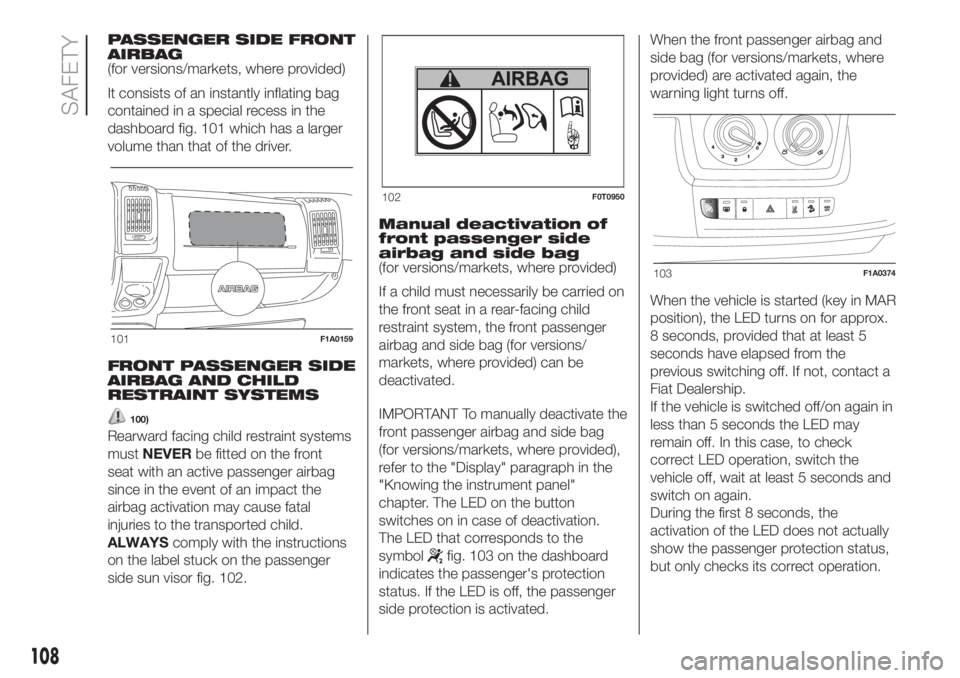
PASSENGER SIDE FRONT
AIRBAG
(for versions/markets, where provided)
It consists of an instantly inflating bag
contained in a special recess in the
dashboard fig. 101 which has a larger
volume than that of the driver.
FRONT PASSENGER SIDE
AIRBAG AND CHILD
RESTRAINT SYSTEMS
100)
Rearward facing child restraint systems
mustNEVERbe fitted on the front
seat with an active passenger airbag
since in the event of an impact the
airbag activation may cause fatal
injuries to the transported child.
ALWAYScomply with the instructions
on the label stuck on the passenger
side sun visor fig. 102.Manual deactivation of
front passenger side
airbag and side bag
(for versions/markets, where provided)
If a child must necessarily be carried on
the front seat in a rear-facing child
restraint system, the front passenger
airbag and side bag (for versions/
markets, where provided) can be
deactivated.
IMPORTANT To manually deactivate the
front passenger airbag and side bag
(for versions/markets, where provided),
refer to the "Display" paragraph in the
"Knowing the instrument panel"
chapter. The LED on the button
switches on in case of deactivation.
The LED that corresponds to the
symbol
fig. 103 on the dashboard
indicates the passenger's protection
status. If the LED is off, the passenger
side protection is activated.When the front passenger airbag and
side bag (for versions/markets, where
provided) are activated again, the
warning light turns off.
When the vehicle is started (key in MAR
position), the LED turns on for approx.
8 seconds, provided that at least 5
seconds have elapsed from the
previous switching off. If not, contact a
Fiat Dealership.
If the vehicle is switched off/on again in
less than 5 seconds the LED may
remain off. In this case, to check
correct LED operation, switch the
vehicle off, wait at least 5 seconds and
switch on again.
During the first 8 seconds, the
activation of the LED does not actually
show the passenger protection status,
but only checks its correct operation.
101F1A0159
102F0T0950
103F1A0374
108
SAFETY